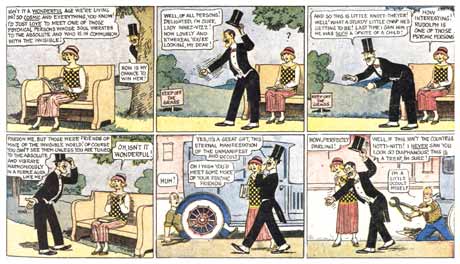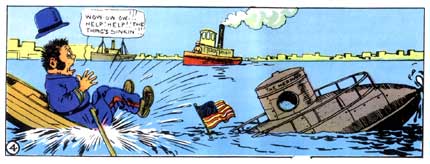'Hairbreadth Harry'.
Charles Kahles was an inventive late 19th-century, early 20th-century U.S. newspaper cartoonist. With his melodramatic newspaper strip 'Hairbreadth Harry', Kahles introduced continuing storylines and cliffhangers to the comics medium. Born in Bavaria, Germany, Charles William Kahles immigrated to the USA at the age of six. He studied art at the Pratt Institute and the Brooklyn Art School. At sixteen, he was employed by the New York Recorder and the New York Journal as a staff artist. Although he plained to become a painter, Kahles eventually had one of the most prolific careers in cartooning.
In 1898, Kahles was hired by the New York World, owned by Joseph Pulitzer, where he created a number of comic features, such as 'The Little Red Schoolhouse', 'Butch the Butcher's Boy', 'The Perils of Submarine Boating', 'Billy Bounce, Pretending Percy', 'The Merry Nobles Three', 'Clumsy Claude', 'Optimistic Oswald' and 'The Kelly Kids'. His 'Clarence the Cop' (1900-1909) stands as the first police strip. Another creation by Kahles, 'Sandy Highflyer, the Airship Man' (1902-1904), was the first aviation comic, preceding even the flights of the Wright Brothers in 1903. Between 2 April 1905 and 18 February 1906, Kahles drew the gag comic 'Tim and Tom. The Terrible Twins', which was obviously inspired by Rudolph Dirks' 'The Katzenjammer Kids'.
'Hairbreadth Harry', 1924.
In 1906, Kahles created his most famous comic strip, 'Our Hero's Hairbreadth Escapes', later known as 'Hairbreadth Harry, the Boy Hero' and eventually simply as 'Hairbreadth Harry'. By 1923, he decided to discontinue all his other strips in order to devote himself entirely to 'Hairbreadth Harry'. For many years, Kahles let his hero continue to rescue Beautiful Belinda from the villain, Relentless Rudolph. Charles Kahles died of a heart attack in 1931, and the feature was continued by F. O. Alexander for another eight years. His daughter, Jessie Kahles Straut, has written his biography.
C.W. Kahles was an influence on Willy Linthout.
'Clarence the Cop', 1924.




